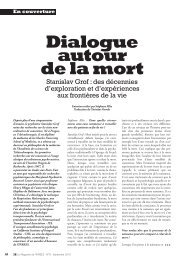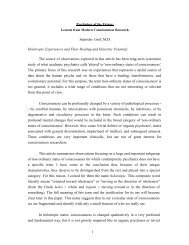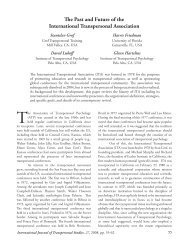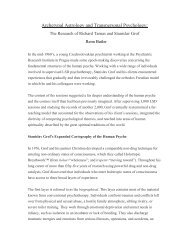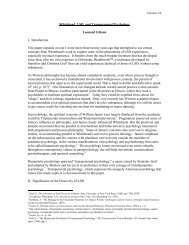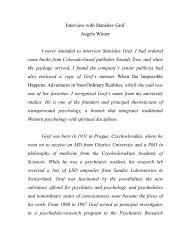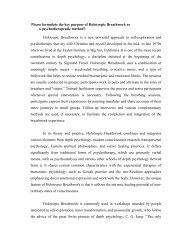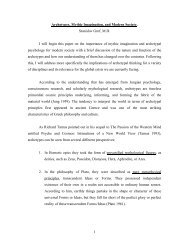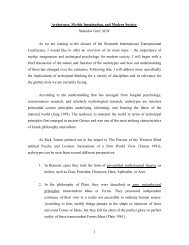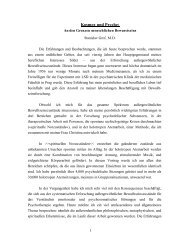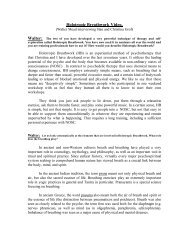1 PSYCHOSIS AND HUMAN SOCIETY: A Historical ... - Stanislav Grof
1 PSYCHOSIS AND HUMAN SOCIETY: A Historical ... - Stanislav Grof
1 PSYCHOSIS AND HUMAN SOCIETY: A Historical ... - Stanislav Grof
Create successful ePaper yourself
Turn your PDF publications into a flip-book with our unique Google optimized e-Paper software.
eactions to situations. Bleuler talked here about dissociation between thought and affect.<br />
Among the primary schizophrenic symptoms was also withdrawal into the fantasy world<br />
and autism. And the last of these was strong emotional ambivalence leading to<br />
conflicting impulses and indecision. Bleuler's definition of schizophrenia and his<br />
classification system have survived with minor modifications until the present day.<br />
Modern psychiatry divides psychotic reactions into two large categories. In the first<br />
of these are organic psychoses - conditions caused by physical changes in the brain or in<br />
the body that can be detected by the existing clinical and laboratory techniques. Typical<br />
examples of this category would be psychological changes accompanying degenerative<br />
processes, cardiovascular disorders, infections, intoxications, and traumatic afflictions of<br />
the brain, typhoid fever or uremia. These belong unquestionably into the domain of<br />
medicine and are of little relevance for the problem of spiritual emergency. What<br />
interests us in this context is the second category of reactions, referred to as functional<br />
psychoses; these lack any known specific organic basis detectable by today's laboratory<br />
methods.<br />
Here belong above all schizophrenic reactions of all four types described above<br />
(schizophrenia simplex, hebephrenica, paranoides, and catatonica) and a mixed form<br />
called undifferentiated schizophrenia. Simple schizophrenia is characterized by a gradual<br />
loss of interests, ambitions, and initiative. As the personality slowly disintegrates, the<br />
person shows neglect for appearance, hygiene, and basic duties; there is a strong<br />
tendency toward withdrawal and social isolation. Hebephrenic schizophrenia involves a<br />
marked regression to primitive, disorganized, and uninhibited behavior that can look like<br />
a caricature of manners observed during puberty, such as grinning, grimacing and<br />
inappropriate outbursts of laughter. Paranoid schizophrenia usually shows less<br />
regression, has greater ego resources, and is socially better established. Patients with this<br />
form of psychosis can have hallucinations and delusions of persecution and grandeur.<br />
Their general attitude is suspicious and often aggressive. Their intellect typically remains<br />
surprisingly intact outside of the area of delusions. And finally catatonic schizophrenia<br />
has as its most characteristic feature extreme changes in motor behavior which can range<br />
from complete inactivity and stupor to severe agitation. Catatonics can also show various<br />
bizarre forms of behavior; they repeat sentences they hear from other people (echolalia),<br />
imitate in a mirror-like fashion their movements and gestures (echopraxia), or maintain<br />
for many hours various unnatural postures (flexibilitas cerea, waxy flexibility). They<br />
might not respond to ordinary speech, but react to whispering or to orders given in a<br />
11




